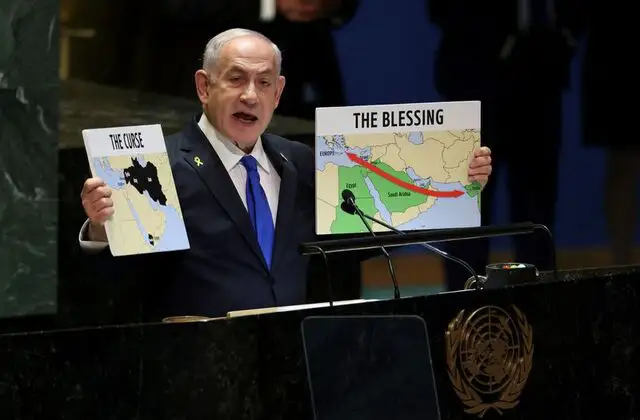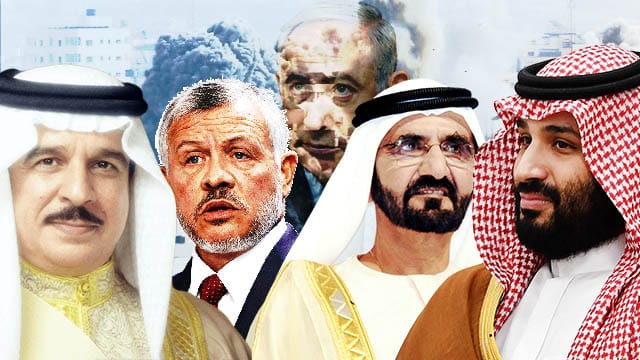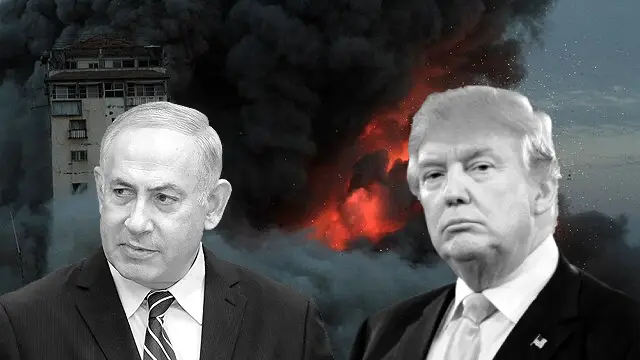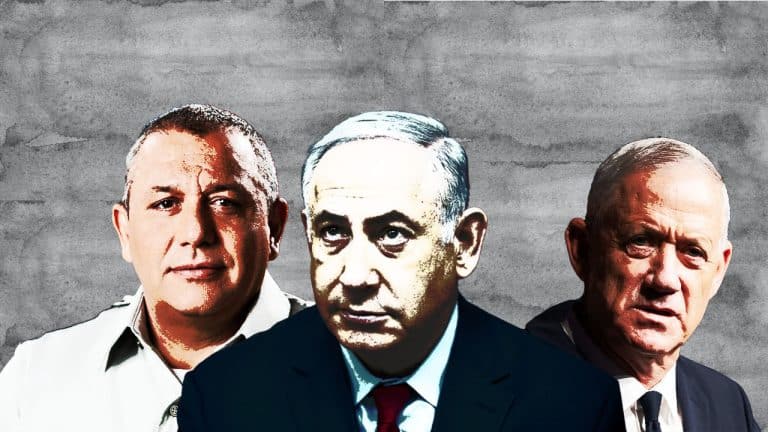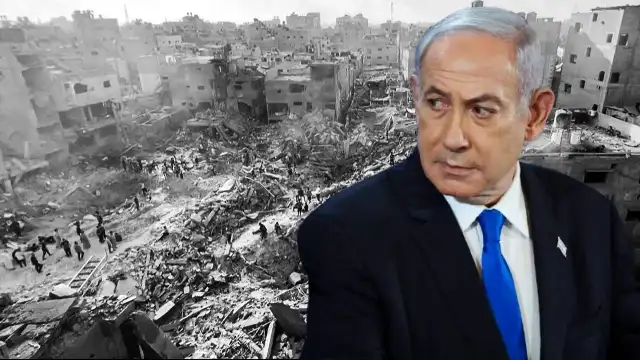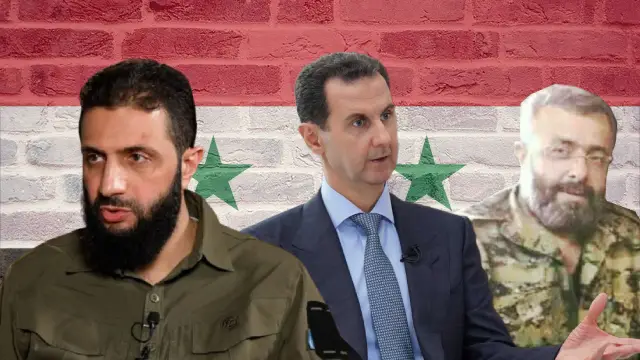Beleaguered Israeli Prime Minister Benjamin Netanyahu finds himself in a tight spot in New York, where he is visiting for his annual speech at the United Nations General Assembly (UNGA). Unlike in the past, Mr Netanyahu’s UNGA address and overall visit have turned into a disaster for US-Israeli public relations machinery.
On the streets, outside his hotel—Loews Regency NY Hotel—thousands of protesters have gathered, demanding his arrest. The protesters may be facing the NYPD’s brutal attacks but are safe from Israeli airstrikes or electronic attacks.
Inside the UN, Mr Netanyahu faced severe embarrassment as several UN delegates from different countries staged a walkout when he reached the podium. The hall echoed with “shame” and amid such ignominious optics, the Israeli prime minister had to deliver his speech, of rhetoric and no substance.
Although Mr Netanyahu may have counted his stars that no shoe came flying towards him like George W Bush faced in Iraq, the massive disapproval of him has caused immense embarrassment that he will carry home.
However, what remains problematic in Mr Netanyahu’s UNGA speech isn’t labelling his opponents “anti-Semitists” or blaming Hamas for the Gaza aggression that has killed over 41,000 Palestinian civilians including children and women, or denying his involvement in the genocide, but highlighting an American geopolitical plan that connects far-right Hindutva-ruled India with Israel.
Moreover, in his speech, Mr Netanyahu marked the Gulf monarchies that he considers allies of Israel—despite those countries’ denials—and stirred controversy over these countries’ seriousness in resolving the ongoing crisis.
The foes highlighted by Mr Netanyahu’s UNGA speech
While addressing the nearly empty hall, Mr Netanyahu presented two maps of the Middle East. Using biblical references, one map was named “THE BLESSING” and another “THE CURSE”.
The map called Curse highlighted Iran, Iraq, Lebanon, Syria and Yemen in black shade, showing countries Tel Aviv considers as its foes. Mr Netanyahu accused Iran as a threat to world peace, although it has not yet flattened cities in the neighbourhood in recent years.
He alleged that Tehran has been designing nuclear warheads for its ballistic missiles.
It’s like the West’s mainstream press accusing Iran of developing its nuclear weapon within a “week” for over a decade.
The Curse map also highlighted the pain point for Mr Netanyahu and his patrons in the US and the UK—Yemen. As Yemen’s Houthi rebels have been successfully targeting ships connected to Israel from passing through the Gulf of Aden, Mr Netanyahu blamed them for destroying millions of lives through inflation, without specifically highlighting a single such case in Asia.
However, Mr Netanyahu’s UNGA speech attacking Yemen proved that the tactics adopted by the Houthis, who are backed by Iran and are a part of its so-called ‘Axis of Resistance’ in the region, have hit Israel where it hurts it and despite the US and the UK illegally bombing Yemen, they have failed to protect the marine traffic.
His attacks on Iran indicate that Tel Aviv will continue to build western consensus using its lobbying tactics to reinforce sanctions on Iran. It appears Mr Netanyahu is waiting for Donald Trump’s return to power so that Iran is again punished by the West.
Israel’s friends in the Middle East
The Israeli map named Blessing shows Jordan, Saudi Arabia and the UAE as allies. Since the beginning of Israel’s aggression on Gaza last year, these countries have taken a weak stance against Israel. They have issued statements and held meetings but didn’t do anything to particularly help the Palestinian people trapped in Gaza.
Even during Iran’s attack on Israel following an Israeli airstrike targeting its embassy in Syria, which killed top generals, Jordan had closed its airspace to Iranian missiles, while allowing the US to use them. Jordan’s reliance on water shared by Israel and its close ties with the US have been blamed for its collaboration.
Saudi Arabia, with which Iran has been improving its relationship lately under the aegis of China, has also remained non-committal towards the cause of the suffering Palestinians. Its only action against Israel has been scaling down the process of establishing diplomatic ties following Mr Trump’s Abraham Accord.
The UAE, another powerful entity in the region with a moderate armed force and American military aircraft, has been working closely with Israel for years and won’t scale down its engagement under any condition it seems.
The India connection in Netanyahu’s UNGA speech
While highlighting the Blessing map, Mr Netanyahu showed a green line connecting Israel with Jordan, Saudi Arabia and the UAE. The line extends from the Arabian Sea to the Indian Ocean, indicating India. Mr Netanyahu emphasised that this is the map of prosperity as through it railways will ply, cargo will move and optical fibre cables will connect communities.
The entire map appeared as a rough sketch of the US-led India-Middle East-Europe Economic Corridor (IMEC), which was proposed during the G20 Summit held in New Delhi last year and also during the G7 Summit held in Italy in June this year.
The ambitious project, which may get sponsorship from the World Bank—its chief Ajay Banga was a part of the meeting at the G20 Summit—aims to counter China’s popular Belt-Road Initiative (BRI). As the BRI also connects countries with infrastructure development for economic prosperity and to revive China’s ancient Silk Route, the IMEC has been proposed by the US to ensure Beijing’s growing impact is curbed in the Middle East.
India and the US plan to build railway infrastructure in the UAE, Saudi Arabia, Jordan, and Israel, despite not having any infrastructure for high-speed railways of their own.
The cargo will travel from Mumbai or Mundra Port of India via the Arabian Sea to the UAE, from where it will travel through railways to Israel’s Haifa Port via Saudi Arabia and Jordan. From Haifa, the cargo will travel across the Mediterranean Sea to either Greece or Italy, which will be the gateway to Europe.
Made with Visme
Now, the Mundra Port in the Indian state of Gujarat is owned by India’s richest man Gautam Adani, who owns the port-to-power conglomerate Adani Enterprises.
The controversial corporate tycoon, accused of share market manipulation and other scams, is perceived to be close to Prime Minister Narendra Modi. India’s Opposition alleges that Mr Modi has been generously handing over India’s national resources and even international resources to Mr Adani.
In 2022, Mr Adani also bought 70% stakes in the Haifa Port paying $1.18bn. He has been also vying for two of Greece’s ports, about which Mr Modi did some initial pitching during his Greece visit.
Mr Netanyahu’s UNGA speech highlighted the project, which India has been hailing as a game-changer—vis-a-vis its bête noire China—since the G20 Summit, shows that there can be more than what the eyes can see regarding the Gaza genocide or the expansion of Israel’s aggression targeting Lebanon.
Money behind the conflict?
It’s alleged than more than fighting Hamas or Hezbollah, the Islamist organisations it once preferred over left-wing resistance organisations, Israel wants to earn more money from the current aggressions.
Gas and oil
According to a study by the United Nations Trade and Development (UNCTAD), there can be huge deposits of fossil fuel and natural gases—122 trillion cubic foot of gas and 1.7bn barrels of oil—in the Levant basin. It’s estimated to provide a share of $524bn to the parties involved in the conflict according to the UNCTAD study.
Experts allege that one of the major reasons behind Mr Netanyahu-led far-right Zionists to stoke the conflict in Gaza is to ensure a complete exploitation of the natural resources of occupied Palestine, which the Palestinian people are barred from exploring or drilling.
Ben Gurion Canal project
Israel has the aspiration to implement the Ben Gurion Canal Project which has been pending since the 1960s. It’s an ambitious canal project that plans to connect the Mediterranean with the Red Sea. Before the Houthis started firing volleys of rockets, the plan was profitable. It would have allowed Israel and the West to avoid Egypt’s Suez Canal and use the Ben Gurion Canal for ships.
There have been allegations that the Israelis want to clear Gaza so that the canal may pass through it, making it economically viable.
The destruction of Gaza and its occupation by Israel can allow this project to take place, although without resolving the issue of the Houthi blockade at the Gulf of Adens, the Ben Gurion Canal Project will be rendered useless.
IMEC’s security
While this is on the southern part of the occupied territories, in the north, Israel wants to bomb and destroy the Lebanese towns and villages bordering it to ensure safety to the Haifa Port, which is under the range of Hezbollah rockets fired from these strongholds of the Iran-backed Shiite organisation.
With more bombings and airstrikes on Lebanon, utilising the disarrayed condition of Hezbollah and the nonchalant attitude of the Lebanon Armed Forces, Israel appears to be securing its long-term economic interests tied with IMEC, Mr Adani and the US-India axis.
The constant glorification of the IMEC project and its member countries during Mr Netanyahu’s UNGA speech hints towards the presence of such a nexus, which could’ve been a reason that the US never forced Tel Aviv for a ceasefire and has been funding it incessantly for the genocide.
While speculations were rife before Mr Netanyahu’s UNGA speech, his special advocacy for the IMEC project and his extension of support for the neighbouring Gulf monarchies indicate that there can be more at stake in Israel’s incessant aggressions in the neighbourhood than the sacrosanct goal of “protecting itself” against unarmed Palestinians.
If the IMEC is one of the reasons behind Israel expanding the war in the region—co-incidentally the Hamas attack of October 7th and consecutive Israeli aggression started soon after the preliminary agreement was set after the G20 Summit—then it can become one of the most controversial and blood-laced projects of the present world.
Tanmoy Ibrahim is a journalist who writes extensively on geopolitics and political economy. During his two-decade-long career, he has written extensively on the economic aspects behind the rise of the ultra-right forces and communalism in India. A life-long student of the dynamic praxis of geopolitics, he emphasises the need for a multipolar world with multilateral ties for a peaceful future for all.

